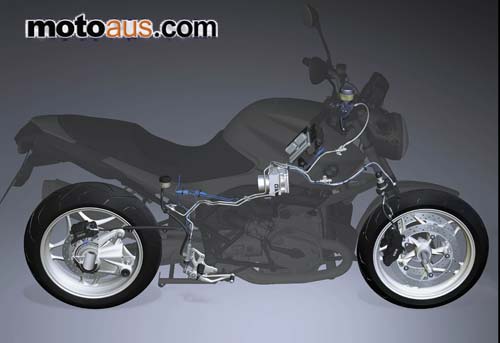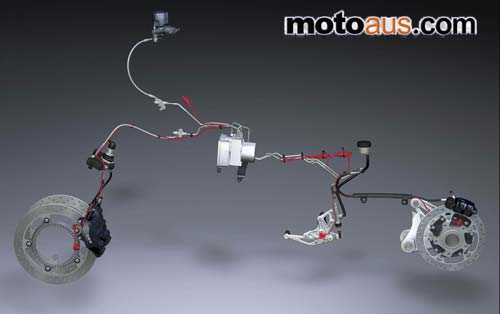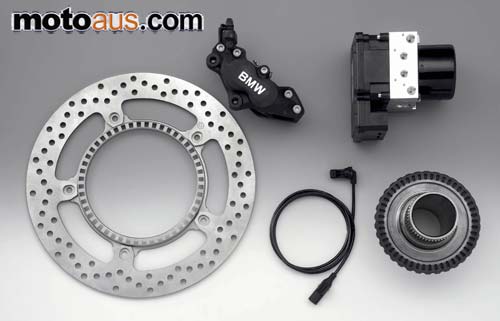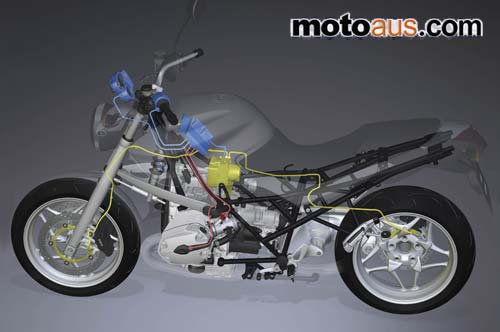The BMW Motorrad ABS system has consistently been developed and technologically updated. Today BMW Motorrad is correctly perceived as the pioneer of innovative safety systems.

BMW Motorrad ABS: A proven history of success.
1988 Production of the first ABS for motorcycles starts with BMW Motorrad.
1992 BMW Motorrad introduces its ‘second generation’ ABS.
2000 Production of the world’s first Integral ABS begins.
2006 Second generation Integral ABS and new ASC introduced.
The dynamic search for the best safety systems has played a key role in the success of BMW Motorrad. BMW was the first manufacturer to offer motorcyclists its electro-hydraulic anti-lock braking system in 1988. At the time it was hailed by the media as the most important development in the field of active safety since the introduction of the disc brake.
The BMW ABS system has consistently been developed and technologically updated. Today BMW Motorrad is correctly perceived as the pioneer of innovative safety systems. Even 20 years on, some competitors are only making their first tentative steps in this direction. Customers expect the highest safety standards from BMW Motorrad.
It is one of the key reasons why Integral ABS has become a standard feature on so many models: the K 1200 GT, K 1200 S, K 1200 LT, and R 1200 RT. For many riders, ABS is an indispensable feature. The high proportion of BMW Motorrad models equipped with ABS (where it can be specified as an option) reflects the BMW rider’s appreciation of the system.

Globally, BMW Motorrad’s Integral ABS is specified by 84 percent of R 1200 GS customers, 92 percent of R 1200 ST customers, and 87 percent of K 1200 R customers. BMW Motorrad Integral ABS comes with either ‘partial’ or ‘full’ integral functioning. This dynamically distributes the braking force to the front and rear wheel according to the wheel load. BMW Motorrad has now developed a new generation of Integral ABS aimed at meeting the needs of the new generation more dynamic sports-oriented machines.
This new generation also offers riders the ability to specify a global innovation: traction control – BMW Motorrad ASC (Automatic Stability Control). Smaller, lighter, refined: New BMW Motorrad Integral ABS. Innovation. Progress. Improved performance. These three hallmarks of BMW advancement are present in the new BMW Integral ABS.
The control unit is noticeably smaller (and thus lighter) than its predecessor, offering a dynamic performance advantage. Compared with the previous Integral ABS, the new Integral ABS enhances the brake system and adapts even better to the rider’s requirements. New electronics ensure a more sensitive response to road surface irregularities and grip changes. The control processes of the new Integral ABS provide distinct feedback to the rider via the brake levers whenever grip levels are exceeded. Rear wheel lift-off control is also improved, which further helps to improve stability during hard braking.

The new BMW Integral ABS is developed from a similar system used by the most potent BMW road cars, the M3 Coupé and M5 Sedan. The new Integral ABS is available as partially integral system. This means that the front as well as the rear brake will be activated together whenever the hand lever is actuated. Both wheels are independently controlled. When the foot brake is activated, it acts only on the rear wheel. ABS system power consumption has also been reduced compared with the previous system, and deleting the brake booster makes the system far quieter in operation.
Further, riders no longer need the ignition switched on in order to access braking power when manoeuvring. The new Integral ABS computes (even faster than before) the optimal distribution of brake forces in relation to the respective load carried, dependent on the weight of the rider, the pillion passenger and luggage.
New BMW Motorrad Integral ABS benefits in summary:
* Significantly enhanced braking controllability (modulation)
* 50 percent unit weight reduction (now just 2.2 kg)
* Reduced maintenance costs (similar to non-ABS motorcycles)
* Enhanced rear wheel lift-off control
* Enhanced braking performance when manoeuvring the motorcycle (even with the ignition switched off)
* Quicker adaptation of the optimal brake force distribution to the respective load carried
* Expanded diagnostic and system monitoring functions
* Reduced power consumption
* Enhanced feedback during ABS deceleration
* Provides data for the ASC
Controlled power anytime: The new BMW Motorrad ASC
BMW Motorrad is currently the only manufacturer to offer a traction control system on a production motorcycle. BMW Automatic Stability Control for motorcycles is an additional function that works in conjunction with the latest generation BMW Integral ABS.
This is yet another example of BMW’s lead in motorcycle safety and innovation. BMW ASC protects riders on roads with varying and lower friction coefficients. The most exciting roads can often have quickly varying surfaces which means changeable traction levels. BMW ASC is able to limit the drive torque transferred by the engine (within physical limits), so as to prevent the rear wheel from spinning, which compromises stability.

In addition to a significant safety improvement, this also means a more efficient use of the power – since ASC will limit power levels to that which the surface can accept. In practice the rider must retain responsibility for their riding style, especially when cornering. BMW ASC reads the ABS wheel sensor information to compare rotation speeds of the wheels.
When differences exceed a predetermined level, power is reduced via the engine management system by retarding the ignition and also suppressing individual injections, if a higher level of control is required. When active, a rapidly flashing ASC warning light illuminates on the dash module. If the motorcycle is being ridden on a track and a degree of wheel slip is desired, the ACS system can be deactivated by pushing a button. This can also be actioned while riding.
Like all BMW electronic systems, the ASC system features a self-diagnosis capability, which alerts the rider should the system become disabled for some reason. A special off-road setup has additionally been developed, specifically for the R 1200 GS and R 1200 GS Adventure. This is adapted to the specific traction levels typically encountered on loose surfaces, such as sand or gravel. Riders simply push the ASC button to shifts the system from the on-road to the off-road mode.
Advantages of BMW Motorrad ASC.
* Largely prevents uncontrolled spinning of the rear wheel
* Provides support for the rider by maintaining the directional stability
* Only puts as much power to the road as the rear wheel can cope with
* Additional safety on roads with lower friction coefficients
* Specific off-road setup for the R 1200 GS and R 1200 GS Adventure
* The ASC may be activated / deactivated while riding.
The right safety system for every BMW.
With the new Integral ABS, BMW Motorrad now offers a complete range of ABS systems precisely tuned to the different categories of motorcycles within the current model range. The R 1200 S and the F 800 S/ST are equipped with the new ABS system, which was specifically designed for lightweight sporting machines and so does not offer the integral function. On the R 1200 S, ABS can be deactivated, ideal for the racetrack.
All new BMW models will feature the latest generation Integral ABS, with the exception of the K 1200 LT and the F 650 models, which continue with their well-proven systems. BMW ASC is available on the following machines: K 1200 S K 1200 R R 1200 GS R 1200 GSA R 1200 R R 1200 RT R 1200 ST BMW ABS and ASC: At the forefront of technology. The latest BMW Motorrad braking and traction control systems are a logical innovation intent on improving safety. They complement the increasing performance of new BMW models. The technology is more powerful, weighs less and requires less maintenance and enhances dynamic safety.
ENDS
